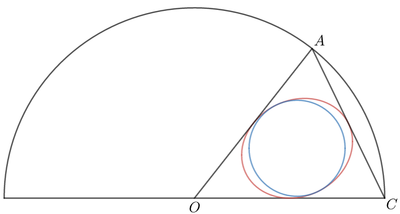The Largest Circle Within the Largest Inellipse
 Note: Not to scale!
Note: Not to scale!
is the center of a unit semicircle, where points and lie on its circumference. Out of all possible maximum ellipse (in red) areas and all possible choices of and , there exists a circle (in blue) within that ellipse with the maximum radius.
If that radius can be expressed as , where are positive integers, and square-free, input as your answer.
The answer is 10.
This section requires Javascript.
You are seeing this because something didn't load right. We suggest you, (a) try
refreshing the page, (b) enabling javascript if it is disabled on your browser and,
finally, (c)
loading the
non-javascript version of this page
. We're sorry about the hassle.
The Steiner ellipse is the maximum inellipse of a triangle, and its semi-major and semi-minor axes are given by 3 1 a 2 + b 2 + c 2 ± 2 Z , were Z = a 4 + b 4 + c 4 − a 2 b 2 − b 2 c 2 − a 2 c 2 .
In this problem a = b = 1 , so the semi-axes are 3 1 1 2 + 1 2 + c 2 ± 2 1 4 + 1 4 + c 4 − 1 2 1 2 − 1 2 c 2 − 1 2 c 2 , which simplify to 6 1 3 c and 6 1 4 − c 2 .
The largest circle in an ellipse would be when its radius is the same as the semi-minor axis, so the one with a maximum radius would be the largest minimum of 6 1 3 c and 6 1 4 − c 2 at a given value of c . Since 6 1 3 c is an increasing function and 6 1 4 − c 2 is a decreasing function (for c > 0 ), the largest minimum of these two would be when 6 1 3 c = 6 1 4 − c 2 , which solves to c = 1 (an equilateral triangle), for semi-axes values (and a radius value) of r = 6 1 3 .
Therefore, A = 1 , B = 6 , C = 3 , and A + B + C = 1 0 .